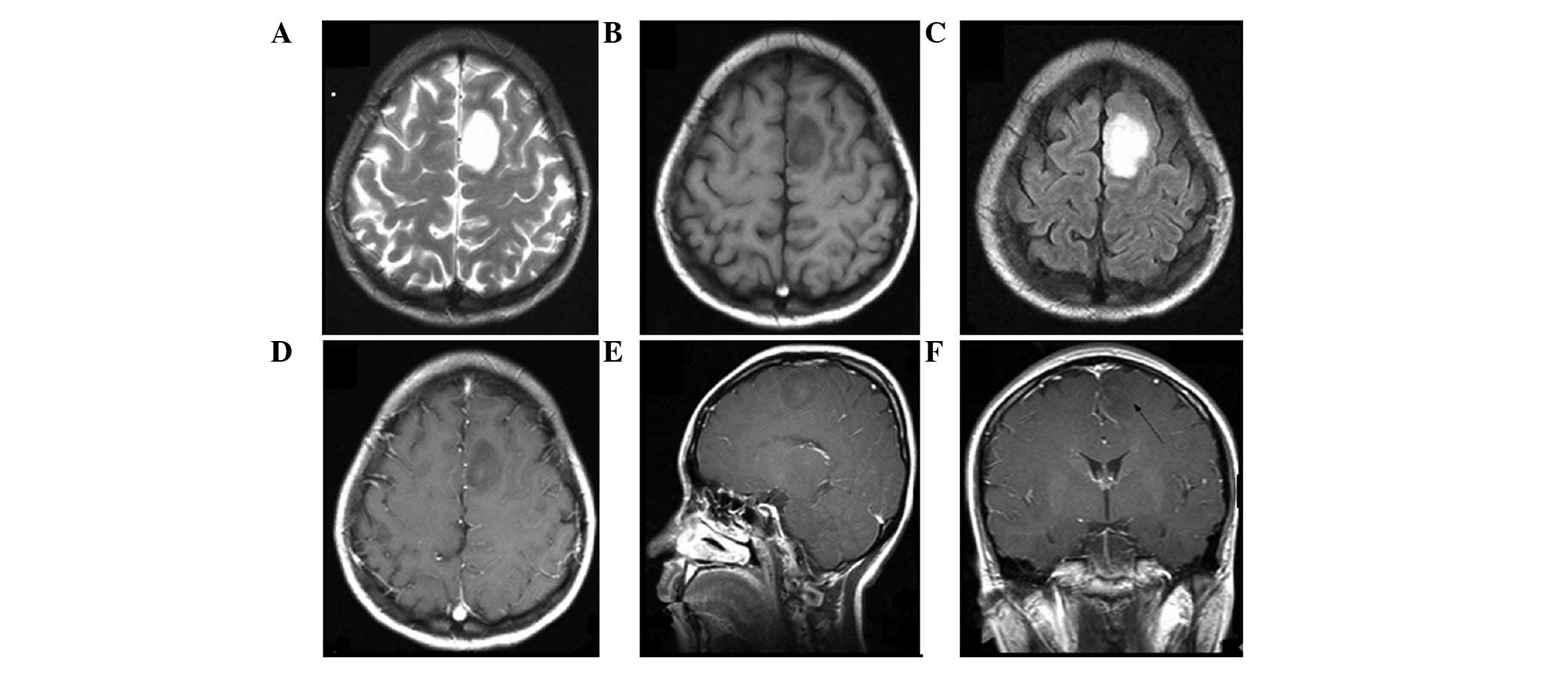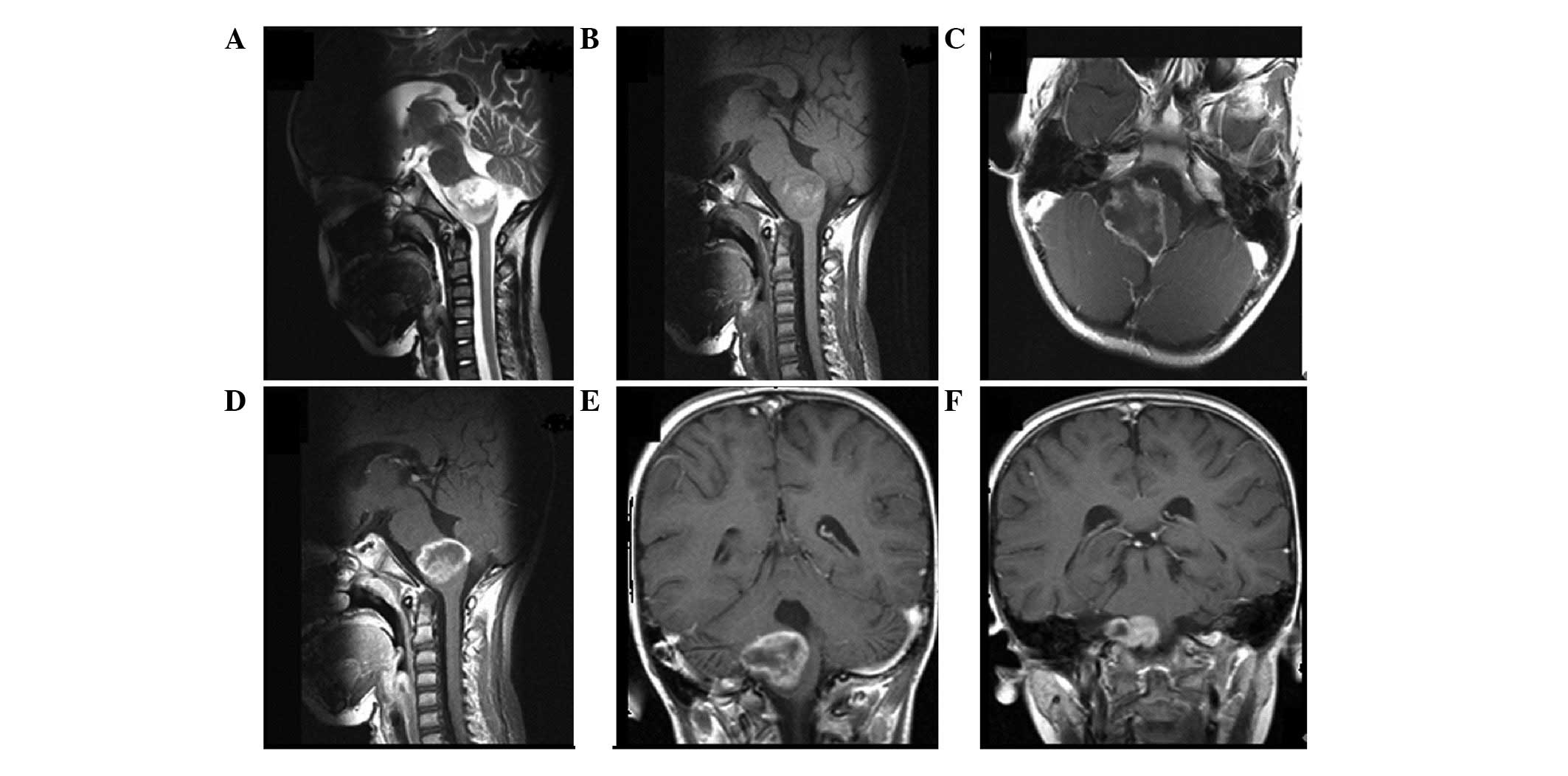|
1
|
Xu BJ, An QA, Srinivasa GS, et al:
Identification of blood protein biomarkers that aid in the clinical
assessment of patients with malignant glioma. Int J Oncol.
40:1995–2003. 2012.
|
|
2
|
Parsons DW, Jones S, Zhang X, et al: An
integrated genomic analysis of human glioblastoma multiforme.
Science. 321:1807–1812. 2008. View Article : Google Scholar : PubMed/NCBI
|
|
3
|
Balss J, Meyer J, Mueller W, Korshunov A,
Hartmann C and von Deimling A: Analysis of the IDH1 codon 132
mutation in brain tumors. Acta Neuropathol. 116:597–602. 2008.
View Article : Google Scholar : PubMed/NCBI
|
|
4
|
Hartmann C, Meyer J, Balss J, et al: Type
and frequency of IDH1 and IDH2 mutations are related to astrocytic
and oligodendroglial differentiation and age: a study of 1,010
diffuse gliomas. Acta Neuropathol. 118:469–474. 2009. View Article : Google Scholar
|
|
5
|
Ichimura K, Pearson DM, Kocialkowski S, et
al: IDH1 mutations are present in the majority of common adult
gliomas but rare in primary glioblastomas. Neuro Oncol. 11:341–347.
2009. View Article : Google Scholar : PubMed/NCBI
|
|
6
|
Watanabe T, Nobusawa S, Kleihues P and
Ohgaki H: IDH1 mutations are early events in the development of
astrocytomas and oligodendrogliomas. Am J Pathol. 174:1149–1153.
2009. View Article : Google Scholar : PubMed/NCBI
|
|
7
|
Yan H, Parsons DW, Jin G, et al: IDH1 and
IDH2 mutations in gliomas. N Engl J Med. 360:765–773. 2009.
View Article : Google Scholar : PubMed/NCBI
|
|
8
|
Nobusawa S, Watanabe T, Kleihues P and
Ohgaki H: IDH1 mutations as molecular signature and predictive
factor of secondary glioblastomas. Clin Cancer Res. 15:6002–6007.
2009. View Article : Google Scholar : PubMed/NCBI
|
|
9
|
Sanson M, Marie Y, Paris S, et al:
Isocitrate dehydrogenase 1 codon 132 mutation is an important
prognostic biomarker in gliomas. J Clin Oncol. 27:4150–4154. 2009.
View Article : Google Scholar : PubMed/NCBI
|
|
10
|
Toedt G, Barbus S, Wolter M, et al:
Molecular signatures classify astrocytic gliomas by IDH1 mutation
status. Int J Cancer. 128:1095–1103. 2011. View Article : Google Scholar : PubMed/NCBI
|
|
11
|
Qi ST, Yu L, Lu YT, et al: IDH mutations
occur frequently in Chinese glioma patients and predict longer
survival but not response to concomitant chemoradiotherapy in
anaplastic gliomas. Oncol Rep. 26:1479–1485. 2011.
|
|
12
|
Reitman ZJ and Yan H: Isocitrate
dehydrogenase 1 and 2 mutations in cancer: alterations at a
crossroads of cellular metabolism. J Natl Cancer Inst. 102:932–941.
2010. View Article : Google Scholar : PubMed/NCBI
|
|
13
|
Kloosterhof NK, Bralten LB, Dubbink HJ,
French PJ and van den Bent MJ: Isocitrate dehydrogenase-1
mutations: a fundamentally new understanding of diffuse glioma?
Lancet Oncol. 12:83–91. 2011. View Article : Google Scholar : PubMed/NCBI
|
|
14
|
Labussiere M, Sanson M, Idbaih A and
Delattre JY: IDH1 gene mutations: a new paradigm in glioma
prognosis and therapy? Oncologist. 15:196–199. 2010. View Article : Google Scholar : PubMed/NCBI
|
|
15
|
Zou P, Xu H, Chen P, et al: IDH1/IDH2
mutations define the prognosis and molecular profiles of patients
with gliomas: a meta-analysis. PLoS One. 8:e687822013. View Article : Google Scholar : PubMed/NCBI
|
|
16
|
Louis DN, Ohgaki H, Wiestler OD, et al:
The 2007 WHO classification of tumours of the central nervous
system. Acta Neuropathol. 114:97–109. 2007. View Article : Google Scholar : PubMed/NCBI
|
|
17
|
Reed GH, Kent JO and Wittwer CT:
High-resolution DNA melting analysis for simple and efficient
molecular diagnostics. Pharmacogenomics. 8:597–608. 2007.
View Article : Google Scholar : PubMed/NCBI
|
|
18
|
Dang L, Jin S and Su SM: IDH mutations in
glioma and acute myeloid leukemia. Trends Mol Med. 16:387–397.
2010. View Article : Google Scholar : PubMed/NCBI
|
|
19
|
Yen KE, Bittinger MA, Su SM and Fantin VR:
Cancer-associated IDH mutations: biomarker and therapeutic
opportunities. Oncogene. 29:6409–6417. 2010. View Article : Google Scholar : PubMed/NCBI
|
|
20
|
Metellus P, Coulibaly B, Colin C, et al:
Absence of IDH mutation identifies a novel radiologic and molecular
subtype of WHO grade II gliomas with dismal prognosis. Acta
Neuropathol. 120:719–729. 2010. View Article : Google Scholar : PubMed/NCBI
|
|
21
|
Persson AI, Petritsch C, Swartling FJ, et
al: Non-stem cell origin for oligodendroglioma. Cancer Cell.
18:669–682. 2010. View Article : Google Scholar : PubMed/NCBI
|
|
22
|
Ohgaki H and Kleihues P: Genetic
alterations and signaling pathways in the evolution of gliomas.
Cancer Sci. 100:2235–2241. 2009. View Article : Google Scholar : PubMed/NCBI
|
|
23
|
Wen PY and Kesari S: Malignant gliomas in
adults. N Engl J Med. 359:492–507. 2008. View Article : Google Scholar : PubMed/NCBI
|
|
24
|
Zlatescu MC, TehraniYazdi A, Sasaki H, et
al: Tumor location and growth pattern correlate with genetic
signature in oligodendroglial neoplasms. Cancer Res. 61:6713–6715.
2001.PubMed/NCBI
|
|
25
|
Mueller W, Hartmann C, Hoffmann A, et al:
Genetic signature of oligoastrocytomas correlates with tumor
location and denotes distinct molecular subsets. Am J Pathol.
161:313–319. 2002. View Article : Google Scholar : PubMed/NCBI
|
|
26
|
Huang L, Jiang T, Yuan F, Li GL, Liu EZ
and Wang ZC: Correlations between molecular profile and tumor
location in Chinese patients with oligodendroglial tumors. Clin
Neurol Neurosurg. 110:1020–1024. 2008. View Article : Google Scholar : PubMed/NCBI
|
|
27
|
Laigle-Donadey F, Martin-Duverneuil N,
Lejeune J, et al: Correlations between molecular profile and
radiologic pattern in oligodendroglial tumors. Neurology.
63:2360–2362. 2004. View Article : Google Scholar : PubMed/NCBI
|
|
28
|
Gozé C, Rigau V, Gibert L, Maudelonde T
and Duffau H: Lack of complete 1p19q deletion in a consecutive
series of 12 WHO grade II gliomas involving the insula: a marker of
worse prognosis? J Neurooncol. 91:1–5. 2009.PubMed/NCBI
|
|
29
|
Eoli M, Bissola L, Bruzzone MG, et al:
Reclassification of oligoastrocytomas by loss of heterozygosity
studies. Int J Cancer. 119:84–90. 2006. View Article : Google Scholar : PubMed/NCBI
|
|
30
|
Eoli M, Menghi F, Bruzzone MG, et al:
Methylation of O6-methylguanine DNA methyltransferase and loss of
heterozygosity on 19q and/or 17p are overlapping features of
secondary glioblastomas with prolonged survival. Clin Cancer Res.
13:2606–2613. 2007. View Article : Google Scholar : PubMed/NCBI
|
|
31
|
Drabycz S, Roldán G, de Robles P, et al:
An analysis of image texture, tumor location, and MGMT promoter
methylation in glioblastoma using magnetic resonance imaging.
Neuroimage. 49:1398–1405. 2010. View Article : Google Scholar : PubMed/NCBI
|
|
32
|
Megyesi JF, Kachur E, Lee DH, et al:
Imaging correlates of molecular signatures in oligodendrogliomas.
Clin Cancer Res. 10:4303–4306. 2004. View Article : Google Scholar : PubMed/NCBI
|
|
33
|
Jenkinson MD, du Plessis DG, Smith TS,
Joyce KA, Warnke PC and Walker C: Histological growth patterns and
genotype in oligodendroglial tumours: correlation with MRI
features. Brain. 129:1884–1891. 2006. View Article : Google Scholar : PubMed/NCBI
|
|
34
|
Jenkinson MD, Smith TS, Brodbelt AR, Joyce
KA, Warnke PC and Walker C: Apparent diffusion coefficients in
oligodendroglial tumors characterized by genotype. J Magn Reson
Imaging. 26:1405–1412. 2007. View Article : Google Scholar : PubMed/NCBI
|
|
35
|
Jenkinson MD, Smith TS, Joyce KA, et al:
Cerebral blood volume, genotype and chemosensitivity in
oligodendroglial tumours. Neuroradiology. 48:703–713.
2006.PubMed/NCBI
|
|
36
|
Walker C, du Plessis DG, Fildes D, et al:
Correlation of molecular genetics with molecular and morphological
imaging in gliomas with an oligodendroglial component. Clin Cancer
Res. 10:7182–7191. 2004. View Article : Google Scholar : PubMed/NCBI
|
|
37
|
Aghi M, Gaviani P, Henson JW, Batchelor
TT, Louis DN and Barker FN II: Magnetic resonance imaging
characteristics predict epidermal growth factor receptor
amplification status in glioblastoma. Clin Cancer Res.
11:8600–8605. 2005. View Article : Google Scholar
|
|
38
|
van den Bent MJ, Dubbink HJ, Marie Y, et
al: IDH1 and IDH2 mutations are prognostic but not predictive for
outcome in anaplastic oligodendroglial tumors: a report of the
European Organization for Research and Treatment of Cancer Brain
Tumor Group. Clin Cancer Res. 16:1597–1604. 2010.
|
|
39
|
Dubbink HJ, Taal W, van Marion R, et al:
IDH1 mutations in low-grade astrocytomas predict survival but not
response to temozolomide. Neurology. 73:1792–1795. 2009. View Article : Google Scholar : PubMed/NCBI
|











